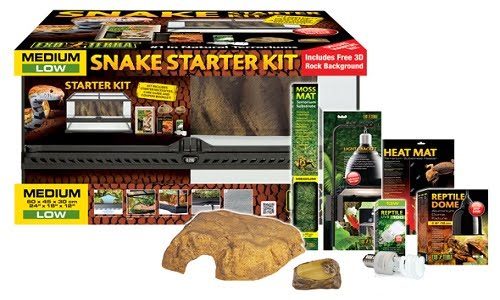
This snake belongs to the Colubridae family (Colubridae). Its name, “Lampropeltis”, means “Bright Shield”. It is distributed in California, Colorado, Oregon, Utah, and Arizona.
Its body is thin and elongated, and it can measure from 40 to 50 inches. It is usually black color and has 30 to 50 yellow or white rings distributed throughout the torso perpendicularly. We can catch an albino variety (white), which is quite common.
Sexing the California Kingsnake
If we desire to know the sex of our diapsid reptile we need to take it to a specialist. In their natural habitat, they have a life expectancy of approximately 10 years, while in confinement they can live up to 20 years.
Conduct and care:
It is a kind of calm and lonely snake, although it looks for company in the time of hibernation: This period usually starts in December, so three weeks earlier they have to be ready, suspending the food in order to avoid digestive problem s; the temperature will be Slowly lowered during 2 weeks, keeping it in a dark place, at 50-60 ºF; it is critical to give water, since it will keep up consuming, thus avoiding possible dehydration; once the hibernation process ends, the temperature will be gradually increased during fifteen days. The specimens that are weak or sick should not be allowed to hibernate, so they will have to continue to be fed in order to achieve this.

During the morning and after sunset it is very active. It sheds its skin in winter, so special care must be taken to ensure that it does not stop feeding. It’s quiet, although you have to be careful because if you disturb it, it can attack. In their natural habitat, they kill their prey by wrapping themselves around it, suffocating it. It does not see well from afar, although it has a magnificent vision from close up, being able to easily locate its prey. In addition, your sense of hearing is highly developed, you can easily hear low-frequency sounds and feel the vibrations of both your targets and possible threats to you.
Feeding and reproduction:
In its natural habitat, it usually feeds on rodents, lizards, eggs, frogs, or birds. It is ophthalmic, that is, they feed on other snakes, whether they are poisonous or not, since they have a certain tolerance to the haemotoxic venom of the same, although they are not immune. If a poisonous snake, such as a rattlesnake, bites you, it can cause your death within a few hours.
In captivity, they can be fed one mouse every twelve to fifteen days. We can sprinkle the rodents with some vitamin or calcium supplement, sold in specialized stores. After feeding them it is not advisable to manipulate them, they should be left for at least 48 hours, so as not to provoke stress or vomiting.
In relation to its reproduction, this snake reaches sexual maturity at approximately 2 years of age. During the months of March and June, they mate, depositing the eggs (3 to 24 units) between May and August. After 6 – 10 weeks, the pups will be born, measuring 20 – 25 cm, from which the mother will initially be disengaged. In captivity, they can lay eggs twice a year and before this happens it is advisable that they have gone through the hibernation period.
California King Snake Terrarium:
The snake terrarium must be suitable for the size of our snake, which can stretch inside it: if it is for an adult specimen, the measurements could well be 24x18x12 inches for a 20-gallon reptile tank; if it is for a young specimen, a container measuring 12x8x6 inches would be sufficient. It is not prudent to leave two or more specimens to be together in the same vivarium, as they might fight. They can only come together to copulate.

California kingsnake should be conditioned with lodging to hide in, consisting of small rocks or using a dark container. We can also provide you with trunks or some branches so that you can climb. It does not need high humidity, 40 – 50% would be sufficient. It must have two sides: one hot, with a temperature of between 28 – 29.5 ºC; and the other cold, at 72 – 75 ºF. The substrate is an essential element within the terrarium and needs to be soft, consisting of coconut fiber, newspaper, leaf litter, bark, or synthetic grass.